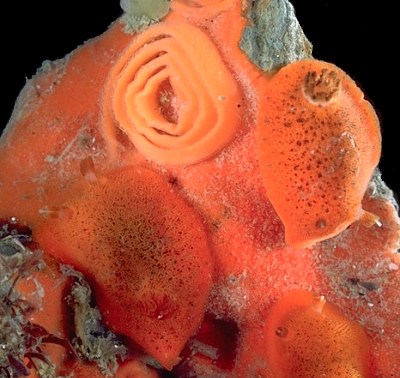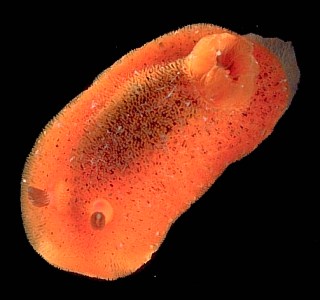

Rostanga muscula
(Abraham, 1877)
Order: NUDIBRANCHIA
Suborder: DORIDINA
Superfamily: EUDORIDOIDEA
Family: Dorididae
DISTRIBUTION
Endemic to New Zealand.
PHOTO
Clifton Beach, near Takapuna, Auckland, New Zealand, December 1986. Many animals ranging in size from 8-21mm long. On Microciona coccinea. PHOTOS: Bill Rudman.
See also R. muscula - Radula.
See also R. muscula - Anatomy.
This is the only species of Rostanga known from New Zealand. It is common intertidally throughout the country and until recently was known as Rostanga rubicunda.
The animal is bright orange-red with scattered black or very dark-brown spots on the mantle epithelium. The density of the blackish spots is variable but in some specimens the epithelium covering the visceral hump between the gills and rhinophores is very heavily pigmented with black or dark brown. The caryophyllidia are translucent whitish. The mantle glands consist of large greyish spherules forming an irregular submarginal row near the mantle edge. There are also white pigment specks and streaks on the mantle skirt in some specimens. The rhinophore stalk is transparent and the club is orange red with some brownish dusting on each of the lamellae. The upper tip of the nearly vertical lamellae is often white and the stalked terminal knob is white. The gills are a translucent orange-red with some brown dusting. In some specimens the inside base of each gill is brown creating a brown ring around the anal papilla. The body is similar in shape to R. arbutus and the tripinnate gills have the shape typical of the genus with a very flattened tip. The gills sit erect in a tight circle forming an almost vertical cylinder. The rhinophore club sits on a stout slightly inflated stalk and consists of about nine almost vertical lamellae which are shortest posteriorly and become gradually longer anteriorly. Surmounting the club is a long stalked knob in the posterior mid-line.
A feeding study by Ayling (1968) showed that in Auckland three poecilosclerid sponges were eaten and there was a clear order of preference from the most preferred, Microciona coccinea, to Clathria (Ophlitaspongia) seriata and then to the least preferred, Holoplocamium neozelanicum. Interestingly, Clathria seriata was an introduced species from Europe which disappeared after a brief period of 3 years. Ayling's study showed that Rostanga have a specific preference in their choice of food sponges and seek their food by chemo-reception.
References:
•Ayling, A. M. (1968) The feeding behaviour of Rostanga rubicunda (Mollusca: Nudibranchia). Tane, 14: 25-42.
•Rudman, W.B. & Avern, G.J. (1989) The genus Rostanga Bergh, 1879 (Nudibranchia: Dorididae) in the Indo-West Pacific. Zoological Journal of the Linnean Society, 96: 281-338.
Rudman, W.B., 2002 (February 5) Rostanga muscula (Abraham, 1877). [In] Sea Slug Forum. Australian Museum, Sydney. Available from http://www.seaslugforum.net/factsheet/rostmusc
